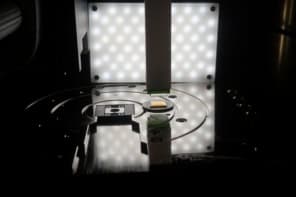Quantized conductance — whereby the current through a wire changes in a stepwise, rather than continuous manner — has been seen in very narrow ribbons of graphene for the first time. The discovery was made by physicists in the US, who claim that this first sighting is an important step towards using such graphene “nanoribbons” in transistors that are much smaller than those used in electronics devices today.
Graphene — which is a 2D sheet of carbon just one atom thick — could have great potential as a material for making tiny electronic devices because it is both a semiconductor and a very good electrical conductor. At just one atom thick, it is about as small as you can get, and unlike many other tiny structures, graphene is relatively easy to work with.
However, graphene is a “zero-gap” semiconductor, meaning that there is no energy gap between its conduction and valence electron-energy levels — and it is such a gap that allows conventional semiconductors such as silicon to be used to make transistors and other electronic devices.
Confined to 1D
One way of creating energy gaps in a material is to make it into an extremely thin wire so that its electrons are effectively confined to move in only one dimension. This creates a series of electron energy levels separated by gaps. If the voltage along such a wire is increased, the current will increase in a stepwise manner because each energy level can accommodate a small fixed number of electrons.
Although such quantized conductance has already been measured in tiny semiconductor nanowires and carbon nanotubes, it had yet to be seen in graphene nanoribbons.
Now, Yu-Ming Lin and colleagues at IBM’s TJ Watson Research Center in New York have seen the effect in graphene nanoribbons (arXiv:0805.0035). The researchers made their nanodevices from single-layer graphene sheets that were placed on a silica/silicon substrate. Nanoribbons as narrow as 30 nm were created by electron beam lithography — a technique that is used in the semiconductor industry. The electrical properties of the nanodevices were then measured at various temperatures.
This phenomenon will allow researchers to achieve various quantum effects in graphene for fundamental research and for technological applicationsYu-Ming Lin, IBM
“The fact that conductance quantization can be observed in our narrow ribbon devices at temperatures as high as 80 K indicates that they have uniform width along the transport channels, and that the channels are of excellent quality,” said Lin. “This phenomenon will allow researchers to achieve various quantum effects in graphene for fundamental research and for technological applications,” Lin told physicsworld.com. “For example, the quantized conductance behaviour in graphene may lead to multi-valued logic operations beyond the conventional binary ones, and may also be used to make 1D electron ‘quantum waveguides’.”
The team will now try to understand the impact of edge disorders on the quantized conductance behaviour of the devices. The scientists also plan to fabricate ultra-narrow channels to achieve quantized conductance at room temperature — something that would be essential for practical devices.



